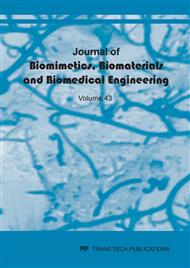[1]
W.E. Brown, L.C. Chow, Cements research progress, in P.W. Brown (Eds), Am. Ceram. Soc. Bull. Westerville, 1987, pp.351-379.
Google Scholar
[2]
T. Kokubo, Bioceramics and their Clinical Applications, first ed. Washington DC, New York, (2008).
Google Scholar
[3]
K. Ishikawa, Bone substitute fabrication based on dissolution-precipitation reactions, Materials. 3 (2010) 1138-1155.
DOI: 10.3390/ma3021138
Google Scholar
[4]
K. Ishikawa, Bioactive ceramics, in P. Ducheyne (Eds), Comprehensive Biomaterials, first ed, Elsevier, Amsterdam, 2011, pp.273-274, 276.
Google Scholar
[5]
X. Fu, W. Lu, D.D.L. Chung, Ozone treatment of carbon fiber for reinforcing cement, Carbon. 39 (1998) 1337-1345.
DOI: 10.1016/s0008-6223(98)00115-8
Google Scholar
[6]
K. Thomas, P.E Hoggan, L. Mariey, J. Lamotte, J.C. Lavalley, Experimental and theoretical study of ozone adsorption on alumina, Catal. Lett. 46 (1997) 77-82.
DOI: 10.1023/a:1019017123596
Google Scholar
[7]
S. Fukuzaki, H. Urano, T. Yamaguchi, Effect of modification of alumina surfaces by ozone on adsorption behavior of bovine serum albumin at alumina-water interfaces, J. Ferment. Bioeng. 84 (1997) 407-413.
DOI: 10.1016/s0922-338x(97)82000-4
Google Scholar
[8]
R.C. Sullivan, T. Thornberry, J.P.D. Abbat, Ozone decomposition kinetics on alumina: effect of ozone partial pressure, relative humidity and repeated oxidation cycles, Atmosph. Chem. Phys. 4 (2004) 1301-1310.
DOI: 10.5194/acp-4-1301-2004
Google Scholar
[9]
C. Tizaoui, M.J. Slater, The design of an industrial waste-water treatment process using adsorbed ozone on silica gel, Proc. Safe. Environ. Protect. 81 (2003) 107-114.
DOI: 10.1205/095758203321832570
Google Scholar
[10]
X. Fu, D.D.L Chung, Improving the bond strength between steel rebar and concrete by ozone treatment of rebar and polymer addition to concrete, Cem. Concr. Res. 27 (1997) 643-648.
DOI: 10.1016/s0008-8846(97)00057-4
Google Scholar
[11]
W. Lu, X. Fu, D.D.L Chung, a comparative study of wettability of steel, carbon, and polyethylene fibers by water, Cem. Concr. Res. 28 (1998) 783-786.
DOI: 10.1016/s0008-8846(98)00056-8
Google Scholar
[12]
D.E. King, Oxidation of gold by ultraviolet light and ozone at 25°C (abstract), J. Vac. Sci. Technol., A.13 (1995) 1247-1253.
Google Scholar
[13]
S. Suzuki, Y. Hori, O. Koga, Decomposition of ozone on natural sand, Bull. Chem. Soc. Jpn. 52 (1979) 3103-3104.
DOI: 10.1246/bcsj.52.3103
Google Scholar
[14]
I. Artilia, M. Maruta, G. Kawachi, K. Tsuru, K. Ishikawa. Improvement of handling property of apatite cement paste, Arch. BioCeram. Res. 10 (2010) 94-97.
Google Scholar
[15]
M. Hott, B. Noel, D. Bernache-Assolant, C. Rey, P.J. Marie, Proliferation and differentiation of human trabecular osteoblatic cells on hydroxyapatite, J. Biomed Mat Res. 37 (1997) 508-516.
DOI: 10.1002/(sici)1097-4636(19971215)37:4<508::aid-jbm9>3.0.co;2-p
Google Scholar
[16]
T. Yuasa, Y. Miyamoto, K. Ishikawa, M. Takechi, Y. Momota, S. Tatehara, M. Nagayama, Effect of apatite cement on proliferation and differentiation of human osteoblast in vitro, Biomaterials. 25 (2004) 1159-1166.
DOI: 10.1016/j.biomaterials.2003.08.003
Google Scholar
[17]
H. Zreiqat, P. Evans, C.R. Howlerr, Effect of surface chemical modification of bioceramic on phenotype of human bone-derived cells, J. Biomed Mat Res. 44 (1999) 389-396.
DOI: 10.1002/(sici)1097-4636(19990315)44:4<389::aid-jbm4>3.0.co;2-o
Google Scholar
[18]
I.H. Loh, Plasma surface modification in biomedical application, Med. Dev. Tech. 10 (1999) 11-12.
Google Scholar
[19]
Y.L. Chang, C.M. Stanford, J.S. Wefel, J.C Keller, Osteoblastic cell attachment to hydroxyapatite-coating implant surface ini vitro, Int. J. of Oral Maxillofac. Implants. 14 (1999) 239-247.
Google Scholar
[20]
D.D Deligianni, N.D. Katsala, P.G. Koutsoukos, Y.F. Missirlis, Effect of surface rougness of hydroxyapatite on human bone marrow cell adhesion, proliferation, differentiation and detachment strength, Biomaterials. 22 (2001) 87-96.
DOI: 10.1016/s0142-9612(00)00174-5
Google Scholar
[21]
H. Kumagai, K. Kusunoki, T. Kobayashi, surface modification of polimers by thermal ozone treatments, AZojomo. 3 (2007) 1-10.
Google Scholar


